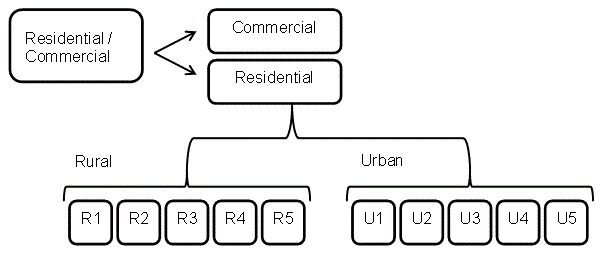Behavioural change¶
With increasing affluence, consumers of final energy are more likely to demand technologies that are more convenient in their use, even if they cost more than less convenient energy forms. Examples of this empirically observed phenomenon are room heating with gas, electricity or district heat, which are more convenient than heating with coal. The affluent end-user does not like to fill up the coal furnace manually and is willing to pay more for a convenient technology. If MESSAGEix is to correctly reflect this phenomenon, the model’s cost-minimizing behavior mustbe modified accordingly. As a model feature to accomplish this task, the concept of inconvenience factors has been introduced in the definition of end-use technologies. The inconvenience factors are specified for each end-use technology, time period and world region. The cost entry in the objective function is calculated as the monetary costs, multiplied by the inconvenience factor. The inconvenience factors for a given world region increase with the level of affluence (GDP per capita) in this region. Flexible and grid-dependent energy technologies, such as electricity, gas and district heating have low inconvenience factors. A second mechanism for taking into account non-monetary decision criteria in the end-use sectors is the application of implicit discount rates which change perceived upfront investment costs by consumers. These two concepts are predominantly applied in the consumer dominated energy end-use sectors transportation (see Transport sector) and residential and commercial (see Residential and commercial sectors). Below, this is described in more detail for the MESSAGEix-Access model, an extension of MESSAGEix that focuses on residential energy services in developing countries which are characterized by high reliance on traditional fuels.
Behavioral change in MESSAGEix-Access¶
MESSAGEix-Access is a variant of the MESSAGEix model that provides a detailed representation of energy use for the residential sector in developing country regions. It is fully integrated with the MESSAGEix supply side model, but not in call scenarios is the the detailed demand-side representation used, but instead a more aggregated formulation with just seven demand categories is used (see Energy demand) which is parametrized off the detailed MESSAGEix-Access formulation. The objective function maximizes household utility by choosing an energy-equipment combination for an individual household group that meets a particular energy service demand at lowest cost. The model is calibrated with data on existing household energy use patterns, derived from national household surveys and energy statistics and balances for the base year 2005. Assumptions regarding urbanization, income growth and changes in income distributions over time drive the model outcomes in the future. In its current version the model is implemented only for 3 of the 11 MESSAGEix regions (see Regions), SAS, PAS and AFR, that are developing regions where access to modern energy remains the most limited.
The model distinguishes between two primary energy end-uses in the residential sector – (1) thermal, largely cooking demand and (2) electricity demand for lighting and appliance use. Several alternative fuel and technology options can be specified in the model to meet each of these respective service demands. To reflect heterogeneity among consumers, the household or residential sector is further disaggregated into several sub-groups that distinguish among rural and urban households and five or more expenditure classes within the rural and urban sub-sectors (Fig. 3).
The methodology for modeling energy choices in the residential sector of this model is described in detail in Ekholm et al. (2010) [11] and in the Supplementary Materials section of Pachauri et al. (2013) [68]. In addition to energy prices, technology costs and performance parameters, and income level of a household determining the least-cost energy-equipment combination that meets a specific energy need, two additional parameters determine choices in the model. The first is referred to as the “inconvenience cost”. An inconvenience cost is a cost related to the inconveniences associated with obtaining and using certain types of fuels. For example, gathering firewood involves an opportunity cost for the time spent in collecting it and a dis-utility to users from exposure to the smoke they inhale when it is combusted. This non-monetary cost is captured by estimating an inconvenience cost (see Ekholm et al. (2010) [11] for further details regarding the methodology) for each household group and fuel. This is considered an additional cost that must be taken into account by the household in making a decision regarding the choice of fuels. The second parameter that also determines energy choices for households is income dependent implicit discount rates that determine the annualized capital costs of equipment depending on their individual lifetimes.

Fig. 3 Split of residential energy demand into different spatial (urban/rural) and income (1-5) categories.¶